My work with schools across the nation on planning and creating makerspaces has proven to me that while anyone can create a makerspace, there are distinct differences between makerspaces and GREAT makerspaces. GREAT makerspaces are unique to your school community, vibrant for now, and sustainable into the future.
Recently on Instagram, I had a series of 7 posts in which I highlighted what I feel are the 7 attributes of a GREAT makerspace. These attributes are meant to serve as a guide for school districts and educators as they plan makerspaces for their school communities. They are as follows:
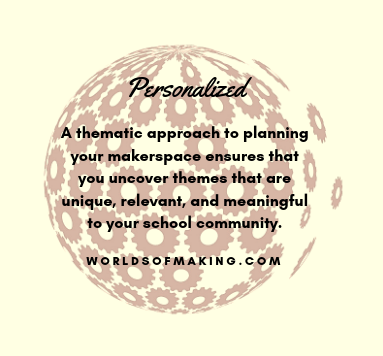 No two makerspaces should be exactly alike, because no two school communities are exactly alike. GREAT makerspaces are personalized and uncover themes that are unique, relevant, meaningful to your school community.
No two makerspaces should be exactly alike, because no two school communities are exactly alike. GREAT makerspaces are personalized and uncover themes that are unique, relevant, meaningful to your school community.
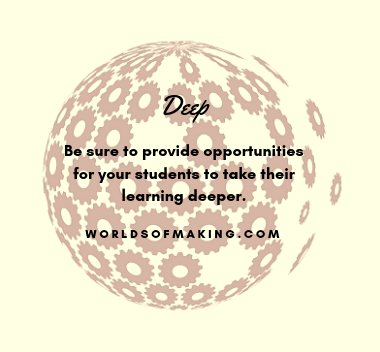 Does your makerspace have depth? GREAT makerspaces have opportunities for students to take their learning deeper. For example, many makerspaces have LEGOs. For those students who love them, it is critical you find additional ways to support the themes behind LEGOs. Students who enjoy LEGOs should have other opportunities to experience engineering, architecture, and design, and not just be limited to one activity. This affords them the opportunity to take their learning deeper than if their experience just began and ended with LEGOs.
Does your makerspace have depth? GREAT makerspaces have opportunities for students to take their learning deeper. For example, many makerspaces have LEGOs. For those students who love them, it is critical you find additional ways to support the themes behind LEGOs. Students who enjoy LEGOs should have other opportunities to experience engineering, architecture, and design, and not just be limited to one activity. This affords them the opportunity to take their learning deeper than if their experience just began and ended with LEGOs.
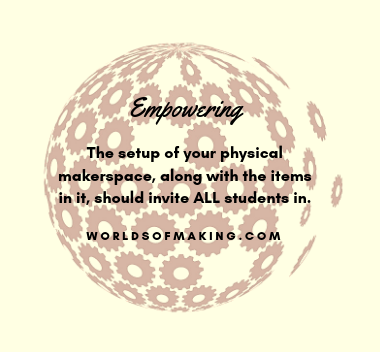 Having a low-barrier of entry into makerspace activities will ensure that any of your students — regardless of their academic proficiency or even whether English is their primary language — can begin making with very little or no teacher facilitation. The setup of your physical makerspace, along with the items in it, should invite ALL students in, therefore engaging them and empowering them. Understand the difference between rigor and difficulty. GREAT makerspaces are inclusive, that they meet the needs of ALL of our learners, and help to build learner independence.
Having a low-barrier of entry into makerspace activities will ensure that any of your students — regardless of their academic proficiency or even whether English is their primary language — can begin making with very little or no teacher facilitation. The setup of your physical makerspace, along with the items in it, should invite ALL students in, therefore engaging them and empowering them. Understand the difference between rigor and difficulty. GREAT makerspaces are inclusive, that they meet the needs of ALL of our learners, and help to build learner independence.
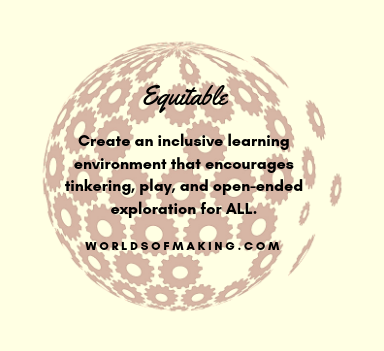 GREAT makerspaces democratize learning. They are equitable by making materials, supplies, and concepts available and accessible to ALL learners. By properly planning your makerspace, you can build an environment that levels the academic playing field for your students. One important attribute of this inclusive learning space is that it encourages tinkering, play, and open-ended exploration for everyone. When you assess the existing curricula, programs, and offerings within your school community, it’s possible to pull out concepts that are frequently taught to a select number of students and make them available and accessible to anyone who has an interest.
GREAT makerspaces democratize learning. They are equitable by making materials, supplies, and concepts available and accessible to ALL learners. By properly planning your makerspace, you can build an environment that levels the academic playing field for your students. One important attribute of this inclusive learning space is that it encourages tinkering, play, and open-ended exploration for everyone. When you assess the existing curricula, programs, and offerings within your school community, it’s possible to pull out concepts that are frequently taught to a select number of students and make them available and accessible to anyone who has an interest.
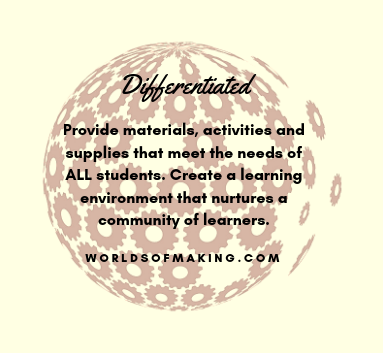 All GREAT makerspaces are differentiated and effectively meet the needs of mixed-ability learners. A suite of multi-modal materials is essential in meeting the varying learning styles of students. Centers or workstations are used to encourage students to collaborate with their peers. The unique learning environment of a makerspace invites students of varying abilities to work together. Creating a community of learners will make all students feel welcomed in your space. Differentiation also includes empowering students to follow their own process for making and creating, rather than attaching a prescriptive process. This type of flexible, self-directed learning will empower as well as enhance all learners’ unique learning abilities. A differentiated makerspace can allow students of all abilities to participate, experience success, and ultimately flourish.
All GREAT makerspaces are differentiated and effectively meet the needs of mixed-ability learners. A suite of multi-modal materials is essential in meeting the varying learning styles of students. Centers or workstations are used to encourage students to collaborate with their peers. The unique learning environment of a makerspace invites students of varying abilities to work together. Creating a community of learners will make all students feel welcomed in your space. Differentiation also includes empowering students to follow their own process for making and creating, rather than attaching a prescriptive process. This type of flexible, self-directed learning will empower as well as enhance all learners’ unique learning abilities. A differentiated makerspace can allow students of all abilities to participate, experience success, and ultimately flourish.
 One of my favorite books is Start With Why, by Simon Sinek. In that book, he talks about the importance of knowing your WHY….the purpose, cause, or belief that inspires you to do what you do. Ask yourself…WHY do you want a makerspace and what will the purpose of the space be? It is important to be able to discover your own unique why and to articulate that vision in the form of a mission statement. GREAT makerspaces are intentional and have a vision that drives their space.
One of my favorite books is Start With Why, by Simon Sinek. In that book, he talks about the importance of knowing your WHY….the purpose, cause, or belief that inspires you to do what you do. Ask yourself…WHY do you want a makerspace and what will the purpose of the space be? It is important to be able to discover your own unique why and to articulate that vision in the form of a mission statement. GREAT makerspaces are intentional and have a vision that drives their space.
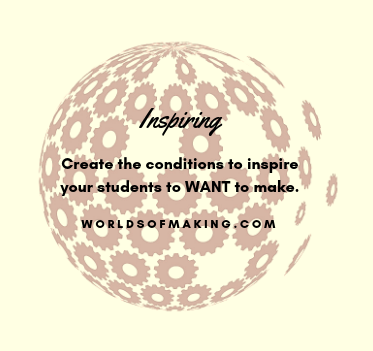 A question I am frequently asked by schools who have makerspaces is: How can we get more of our students engaged in our makerspaces? Many educators feel that their direct instruction is what is needed to engage students in making experiences. While I do believe that there can be a place for some instruction for skill-building in a makerspace, I don’t believe it is the only strategy that should be used for engaging our students; nor is teacher-led instruction the only way we can encourage our students to be creative or innovate. Rather than forcing students to make, GREAT makerspaces are inspiring and create the conditions to inspire our students to WANT to make.
A question I am frequently asked by schools who have makerspaces is: How can we get more of our students engaged in our makerspaces? Many educators feel that their direct instruction is what is needed to engage students in making experiences. While I do believe that there can be a place for some instruction for skill-building in a makerspace, I don’t believe it is the only strategy that should be used for engaging our students; nor is teacher-led instruction the only way we can encourage our students to be creative or innovate. Rather than forcing students to make, GREAT makerspaces are inspiring and create the conditions to inspire our students to WANT to make.
Be sure to check out professional learning offerings available through Worlds of Making, including a ‘Making GREAT Makerspaces’ series!






